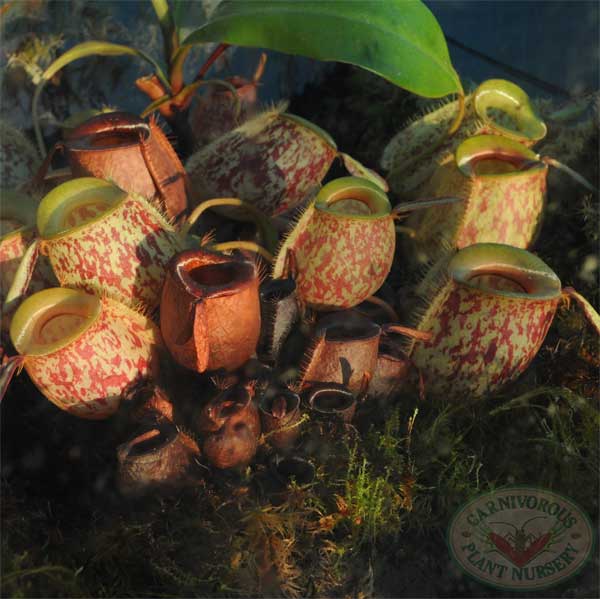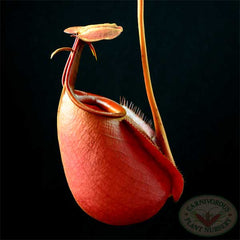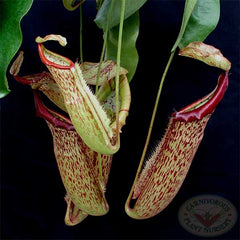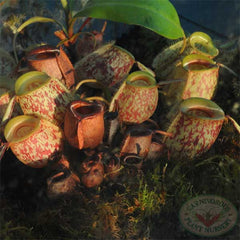
Growing Tips for Nepenthes



Tropical Pitcher Plant - Nepenthes spp.
Soil: 1:1:1:1:1 peat:sand:perlite:fir bark:chopped Sphagnum.
Container: 6" hanging pot.
Watering: moist, but well drained.
Light: full to part sun, some prefer shade.
Temperature: cool for highland species, warm for lowland species.
Humidity: medium to high.
Location: greenhouse, terrarium, windowsill.
Dormancy: no.
Habitat
The Tropical Pitcher Plants, Nepenthes spp. are native to Southeast Asia including Borneo, Sumatra, Malaysia, the Philippines, India, and northern Australia. Nepenthes Pitcher Plants are divided into two distinct groups: the Highland and the Lowland species. Highland species grow on the cool mountainsides and tops. The lowland species grow in the warm foothills and coastal areas. The soil tends to be low in nutrients and high in organic matter. Most grow in acidic soils, though some can be found growing in sand and/or alkaline conditions. Lowland species grow in typical day temperature ranges from 85-95+°F (30-34°C) with nightly cooling into the low 70s°F (18°C). Highland species grow in typical daytime temperatures between 75-85+°F (25-30°C) and night temperatures of low 60s°F (18°C).
Culture
All Nepenthes grow best in continuously warm, humid, and bright conditions. Choose a variety that best matches your growing conditions. Highland species will tolerate cool winters. Lowland species like it hot, humid and bright year round. Heated greenhouses and terrariums can provided an excellent home habitat. Young plants can grow very slowly, even seem to sleep for years, and then grow vigorously. Others take off right away.
Tropical Nepenthes Pitchers Plants can be challenging to care for and grow because of their need for consistently bright, humid and warm conditions. This often requires a greenhouse for sustained culture. Tropical Pitcher Plants prefer good air circulation and a light, well-drained, porous soil. A soil mix of peat, sand, perlite, orchid bark, and chopped Sphagnum works well. Pure live sphagnum moss or “orchid mix” is a good soil alternative. Nepenthes are tolerant of a variety of soil mixes. Keep the soil evenly moist and well drained. Water with mineral-free water from overhead. Mature Nepenthes prefer a hanging pot, basket or plant stand. They like bright, full sun and high humidity. Lowland species prefer hot days and warm nights, and highland species prefer warm days and cooler nights. A day/night temperature difference of 15°F (8°C) is recommended. A misting system is beneficial. Browning of traps or traps not forming is usually a sign of humidity that is too low. This can be remedied by growing in a large clear, vented plastic bag while new pitchers form, and removed once traps are mature. Mature Nepenthes are climbing vines and growing accommodations should provide for this.
They like consistently moist, but draining soil. Water the soil, not the traps, though keeping a small amount,1/2" (1cm) of water in the trap will help it through hot, dry spells. One convenient way to water the whole plant, is to lower the pot into a bucket of water and let it thoroughly soak. Though they prefer mineral free water, they can tolerate occasional tap water more than other Carnivorous Plants. High humidity and good ventilation are important, even in a terrarium. If your conditions are a bit dry, consider frequent misting. Repot with fresh soil mix every few years.
Dormancy
Tropical Pitchers Plants do not require dormancy. They prefer warm, humid winter conditions. Slow growth during the winter months is typical.
Propagation
Nepenthes Pitcher Plants can be propagated from cuttings, that can root in water, or air layering of stems. Seeds are slow and need steady conditions. Tissue Culture works well for clones.
Feeding
Tropical Pitcher Plants are avid feeders. Provided with natural access to insects they will “feed” themselves. They love stink bugs. Even indoors they will attract and capture an occasional fly or other insect. Do not feed them meat or cheese. This will likely rot and kill the trap. If feeding is desired, drop in a few freeze dried bloodworms, dead crickets, wasps or similar insects. Fertilization is not necessary, however an occasional, summer application of orchid food, diluted 10%, will benefit growth. Nepenthes respond well to foliar fertilization. Spray twice a month during the growing season with a dilute (10%) orchid fertilizer.
Other Considerations
Nepenthes plants are either male or female and the flowers can have an unusual fragrance. Unless seeds are desired and one each sex is available, consider removing any flower spikes, as they will draw energy from the plant.
Nepenthes require high humidity. Traps will not form properly, abort, or die back in low humidity. It's not a bad idea to add a small amount of water to each pitcher when you receive the plant, to keep it hydrated until it begins new growth.
Consider placing the plants outside, hanging under a tree in the summer. They will benefit from the bright light and insect laden environment. Keep an eye on the humidity. Frequently misting may be necessary.
Nepenthes are slow growers during their first few years, and can take 5 to 10 years to mature. Once established, they will begin to vine and grow rapidly. At this stage traps stems will loop around and cling to any available support. Be sure to provide ample support for the plants during this vine-growing stage. Flowers occur on the tips of the growing vines. The pitchers on the young plants near the plant base usually have a slightly different shape and coloration than the traps on the upper vines. The upper vines can be cut off and used to start new plants. New growth will emerge from the remaining plant base.
Nepenthes, like most carnivorous plants, benefit from repotting in fresh carnivorous plant soil every few years.
